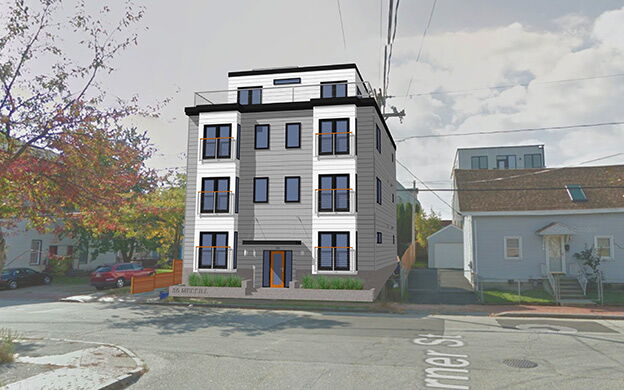Boomer buying continues to grow — in Portland and beyond
 Courtesy / Benchmark Residential and Investment Real Estate
The six-unit 30 Lofts at 30 Merrill St. in Portland is an example of new residential construction that meets buyer demand for modern aesthetics, flexible living space, state-of-the-art efficiencies and walkable neighborhoods.
Courtesy / Benchmark Residential and Investment Real Estate
The six-unit 30 Lofts at 30 Merrill St. in Portland is an example of new residential construction that meets buyer demand for modern aesthetics, flexible living space, state-of-the-art efficiencies and walkable neighborhoods.
Demand by the boomer generation for downtown residential space — whether in Portland or other towns along the coast — continues to grow, said Tom Landry, owner of Benchmark Residential and Investment Real Estate.
Landry’s company has experienced a 27% increase in transaction volume for residential properties during the first quarter of 2017 compared to Q1 2016.
That surge, he said, reflects consumer demand.
“There just seems to be no stop to this trend,” he said
Recent transactions included nailing down 10 contracts in just a two-week period for condominium units at 10 Exchange St. in Portland.
“That’s the fastest-moving sales for any condo complex we’ve ever worked on,” he said.
That address also happens to be where he opened his fourth office, adding to three other offices in Portland. The four are located in the East End, West End, Old Port and arts district. Their locations are in keeping with what clients want in their brokers these days, said Landry.
“When people are making a big decision about whether to sell or buy, they want to know you’re grounded in the neighborhood,” he said. “It matters that you’re not a virtual Realtor, or somewhere in a strip mall and driving into town, or sitting in a coffee shop.”
He added, “It’s indicative of what’s happening in Portland, where there’s so much demand and so much growth.”
Small, reasonably priced condos are being viewed by buyers who frequent Portland as a good alternative to hotels, he said.
“To paraphrase something shared with me by people from away, ‘We’ve come to love Portland; we come twice a month,’” he said. “These small units that are reasonably priced are becoming an alternative to hotels and Airbnb.”
At the same time, he said, landlords of rental units are seeing an opportunity in visitor trends, and are starting to provide flexible rental terms. Traditionally, rental terms are for six months or a year. Landlords are looking at monthly or seasonal rentals to bring in short-term visitors, he said.
Another trend, he said, is demand for lower-priced units by boomer buyers who want to own more than one getaway.
“People are saying, ‘I don’t want a $1 million unit. I’m selling my house in the suburbs and I want to have two or three experiences around the country,’” he said. “So people are taking that $700,000 or $800,000 and buying a place in Portland and maybe in Arizona or California or Florida or the Carolinas. Some people have small crash pads in New York City or Boston or Costa Rica. We’re seeing a lot of people saying, ‘I always wanted a small lake property and an urban experience and someplace warm in the south.’”
Steady growth in residential market
Landry has seen steady growth in residential real estate activity for three years now. Trends show that “the more urban you are and the more coastal you are, the better,” he said. “The highest growth, and the areas that have surpassed the previous highs of 2005-06, are greater Portland, the greater Kennebunk-Kennebunkport-York areas and coastal pockets as you go up the coast.”
An interesting factor is that buyers looking for an “urban” experience don’t necessarily need to be in downtown Portland.
“It can be downtown Gorham or downtown Biddeford or Brunswick,” Landry said. “They aren’t big cities. The idea of walkability and having the things they need for daily life within, say, a mile is what people want.”
Developers and buyers are getting priced out of certain areas of Portland, he said. Properties in cities like Saco and Biddeford, he said, are lower-priced, and just as easily accessible.
“A hundred years ago, these urban centers were thriving, bustling little community centers within a bigger city, and I think we’re getting back to that,” he said.
Boomers also tend to be more interested in space that has an interesting aesthetic, whether in a renovated historic building or new construction.
“The idea that keeps coming up is that we don’t want it to feel like ‘anywhere America’ — that it’s stamped out by a machine or it’s a condo unit that we’ve seen a thousand times over because it’s a formula used in suburban Boston or suburban Atlanta, and you feel like you’re living in glorified hotel room,” Landry said.
Development of small commercial spaces in downtowns is growing in sync with demand for residential space, he said.
“We have people saying, ‘I’m going to develop a commercial space that allows for a coffee shop and for a restaurant and a hair salon.’ We see this along the coast, where people who come here for the summer are demanding services. In Damariscotta, for example, there’s a new place that’s a co-working space and a coffee shop. The idea of having a co-working space in a summer town like Damariscotta would have been inconceivable five years ago. But now we have businesses responding to a need from people who are coming up and saying, ‘We can stay here for the entire summer because I can work from anywhere with high-speed internet.’ People are demanding a different lifestyle. And that flows through real estate.”










Comments